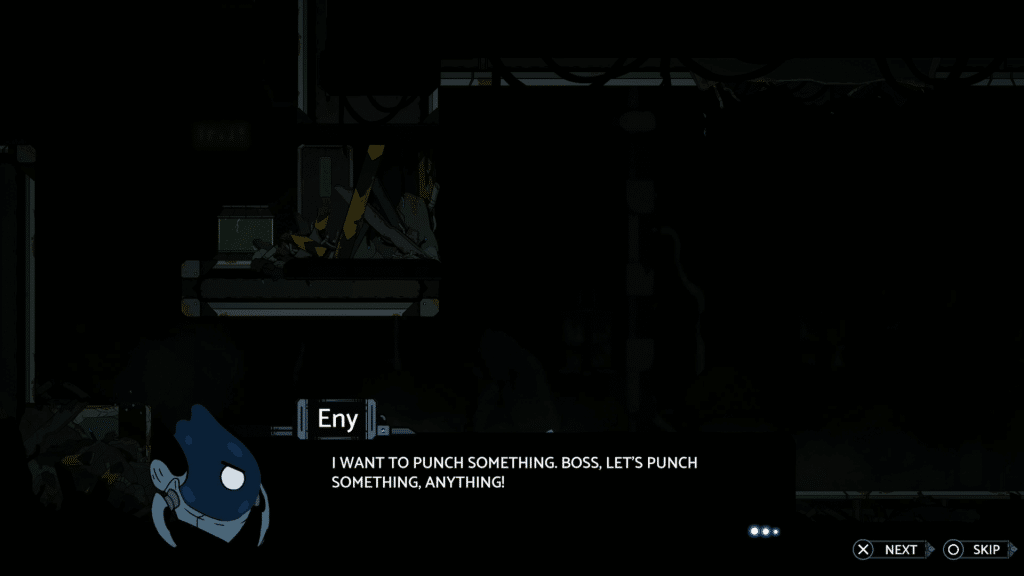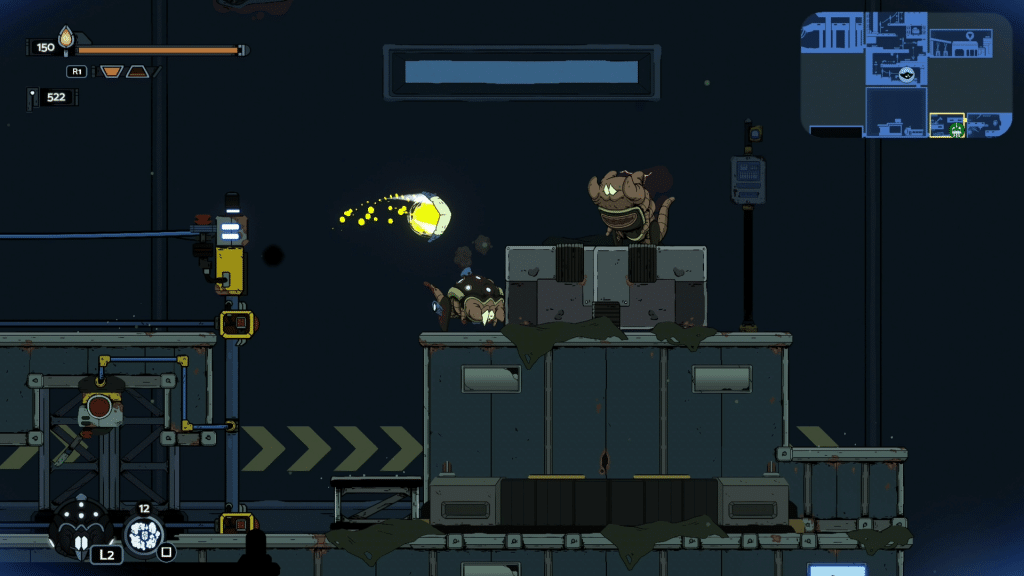When done right, Metroidvanias can be among the most exciting games. Early sections tease players with new possibilities, often hidden behind a specific mechanic, or condition that comes at some point in the future. What makes them exciting is that crystalizing moment when it’s clear the desired item was obtained, and that secret can finally be unlocked. Naturally, they’ve slowly become a go to for developers, and a genre that has changed a lot since its namesakes entered the scene. With Biomorph allowing players to control enemies, it gains a new dimension, but will it be enough to stand out?
Biomorph starts with a familiar, but solid premise. Players control a mysterious creature known as Harlo, whom was trapped on an unfamiliar ship. Despite their memories not being intact, they fight forward with the aid of two companions. The pair add some levity to situations to keep the adventure breezy fun.

After escaping the ship the world expands, with a variety of people for Harlo to help. All the dialogue, and tutorials at the start can be somewhat overwhelming, but once everything is in place it’s an okay ride. Especially when the animated cutscenes appear, which are an absolute delight. Unfortunately, the same can’t be said about gameplay.
On a basic level Biomorph has a lot of potential. Right off the bat Harlo gains a melee attack, followed by a gun, and along the way it’s revealed they can control enemies. Said power is different from Kirby, where it isn’t an approximation, as much as literally controlling an enemy.

Simply Gorgeous
Despite seeming somewhat gimmicky, Biomorph uses this to its advantage. For example, an early enemy can float above traps, another can deal considerable damage, and there is always the option for a ranged attack with certain enemies. It’s a lot of fun, though it’s largely held back by a couple rough patches.
Where the enemy mechanic sounds cool, it isn’t particularly innovative. Instead of offering players a variety of ways to solve any given problem, you just utilize A and B. I can sometimes opt for a different path, though it doesn’t feel particularly special to solve the same problem with a similar solution.

I wouldn’t even mind this approach if Biomorph didn’t feel so dated. This starts with every enemy dealing collision damage. Given range weapons have ammo, and Harlo’s initial main form of combat is melee, it can feel rather cheap. Obviously I can opt to transform into another creature, often offering a more advantageous play style, but said mechanic shouldn’t be the de facto best way to play.
Traps have a similar problem. Things like the electrical traps work like a modern game. I touch them, they deal damage, and then I can either brute force the section, or get to safety. Spikes deal damage, and reset my position. Nothing is less fun than missing a platform, touching a spike, and then being teleported to the top so I can do it again.

This goes back to the transformation system as well. Harlo will take damage, plus reset, whereas a Scarbyttle will simply float. Yet again it’s just defaulting on me utilizing the transformation mechanic, though in this case also unlocking a specific creature, and having them equipped.
Another thing that certainly varies is enemy attacks. While I’m going to applaud Biomorph for utilizing different moves, it kind of sucks trying to figure out what an enemy is going to do. Some of these are obvious, like Klerek have something above their head that is used for a laser attack, whereas a Fubirang unexpectedly shoots a bone out of its chest that boomerangs.

At Least it Looks Like a Boomerang
All of this comes together in a way that just feels frustrating. I try to figure out its attack, guess wrong and take damage. Another time I guess right, but don’t anticipate a follow up, or them simply moving forward, and I take damage.
Odder still, I am not entirely sure what type of experience Biomorph is trying to be. I don’t think any of the mechanics are hard, more so cheap, yet it has a money drop on death mechanic? I know the Souls games are popular, but it just seems out of place. I feel the same way about healing, which takes roughly 3 to 4 seconds to do. This is only a problem against a boss, as any other situation will have ample time to heal.
So Obvious
Finally, I want to touch on the map, which I don’t particularly care for. Typically Metroidvania games leave hints on the map that can be examined to locate different secrets. It can be a lot of fun, unless one is missing and it’s hours of careful examination looking for one random thing off in the world. In Biomorph it’s a surprising accurate depiction of a location. Just one without nuance.
This is best understood by looking at the image above. There I can see a small gap that allows me to progress forward. This would typically be indicated as such on a map, whereas here it’s just not shown. Technically it’s shown as a wall, and the top area I can enter, despite being shown as solid. Like I get the choice is to capture the location, it just isn’t a good deviation from established norms.
Biomorph Review Verdict
Biomorph: People constantly talk about how they want new/different experiences, and while I'd agree that Biomorph accomplishes this, I wouldn't say it automatically makes the experience good. Between dated mechanics, and okay level design it simply doesn't elevate beyond the average experience. Instead it's a hodgepodge of ideas that feel out of place, or ultimately hold back a frankly gorgeous looking game. – Grant
Editor’s Note: Biomorph was reviewed on PlayStation 5, and a copy was provided to us for review purposes.















